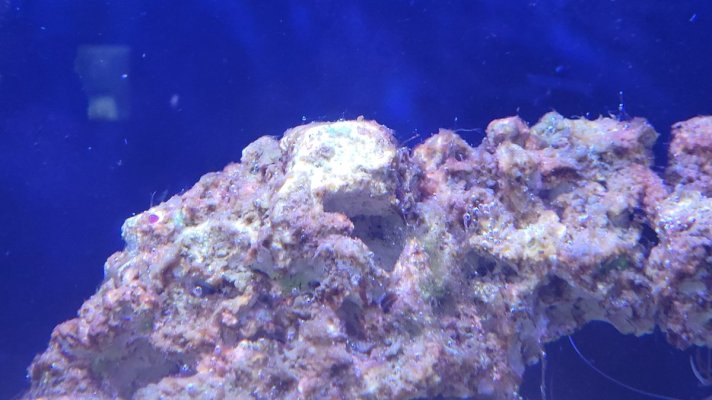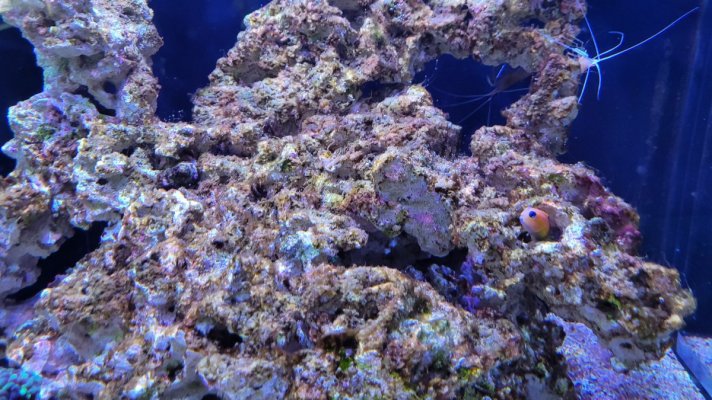Hi All,
I'm in a bit of a difficult spot with Calothrix and precipitation issues and would love some help here.
The system - Reefer 625 G2 set up Aug 28, 2022. 152g water volume.
Water Parameters:
Salinity - 1.026
Alk - 7.2-8.0 dKh (pretty stable at 7.2-7.3 dKh till I tried to raise it and saw precip again)
Cal - 400-425
Magnesium - 1380-1440
Nitrate - 8-12
Phosphate - .02-.08
Temp - 78.5-79.3 F
My tank has been up for ~2 months now, and after running into precipitation during the cycle with the sand bed hardening I cut back drastically on dosing but didn't want to stop entirely since I am trying to do light water changes and rely on heavy filtration with additives to keep the chemistry stable. I currently change 5g a week with Red Sea blue bucket, and have a ReefMat 1200 fleece roller, and a Regal 150INT skimmer running.
The tank started with dry marco rock and dry sand, but I seeded the biome with some MarinePure media from an established (~2y) tank. My goal was to try to keep a nice Alk/Cal level from the start, so I started testing on Day 1 to keep the Alk in the 8-9 range I had success with on the smaller tank. Initially with the lights off during the fishless cycle I saw the alk dropping rapidly (~1dKh) every day so I was dosing with BRS two-part to try to stabilize. After reading some forums I thought it could be the bacteria stripping carbon out of the carbonate so I switched over to BRS Alk only but was still dosing a ton each day (~320mL). I realized one night that the sand bed was hardening so I busted it up, and decided to cut back and keep the Alk at ~7dKh to avoid precipitation issues.
Since I turned on the lights ~6w ago (2w ramp up), I started dosing again to feed the corals I transferred over, starting out at ~80mL per day of BRS two-part to keep the Alk around 7.2 dKh. Since the lights have been on for a while now, I thought I'd try to raise the Cal/Alk slowly to 8-9dKh and 400-420ppm Cal to feed the patches of Coralline I see growing amongst the uglies. Unfortunately I noticed today that the sand bed is hardening again so I need to cut back but now I am in a difficult spot.
The tank is currently overrun by what I think is Calothrix based on the reef cleaners guide, there are some photos below. It has bubbles trapped within, persists overnight, and loses form when I blast most of it off a rock with a turkey baster. Since this is a form of Cyano, I believe the conventional path here would be to maintain good water chemistry/maintenance but beyond cal/alk staying on the low end I've never seen a chemistry issue. I test alkalinity daily and the rest of the params once a week at nearly the same time. There are other patches of red Cyano, GHA, and green film in the tank but they haven't taken over like the Calothrix.
I feed 1 cube of frozen mysis or brine shrimp a day and add ~1/4 tsp of TDO chromaboost through the auto-feeders though a fair bit of the pellets go straight down the overflow. Since I just added a group of 6x Lyretail Anthias I've doubled the autofeeders, and am considering doing the same for the frozen food I feed each night. I've never seen a marked increase in Nitrate/Phosphate as I've increased feeding however since I have both a Reefmat and Skimmer running on the tank. Though that may be because of the increased algae/bacteria growing in the display.
My question is, how do I deal with this issue? I have cyano that seems to demand I raise calcium/alkalinty to encourage competing organisms like coralline but I can't seem to raise those levels without causing precipitation in the sand bed. Should I instead try to raise Nitrate/Phosphate to encourage competing algaes that a CuC/micro fauna will actually eat? How and when can I actually raise the Cal/Alk to where I want them to be (~9dKh, ~420ppm) without causing it to precipitate out?


I'm in a bit of a difficult spot with Calothrix and precipitation issues and would love some help here.
The system - Reefer 625 G2 set up Aug 28, 2022. 152g water volume.
Water Parameters:
Salinity - 1.026
Alk - 7.2-8.0 dKh (pretty stable at 7.2-7.3 dKh till I tried to raise it and saw precip again)
Cal - 400-425
Magnesium - 1380-1440
Nitrate - 8-12
Phosphate - .02-.08
Temp - 78.5-79.3 F
My tank has been up for ~2 months now, and after running into precipitation during the cycle with the sand bed hardening I cut back drastically on dosing but didn't want to stop entirely since I am trying to do light water changes and rely on heavy filtration with additives to keep the chemistry stable. I currently change 5g a week with Red Sea blue bucket, and have a ReefMat 1200 fleece roller, and a Regal 150INT skimmer running.
The tank started with dry marco rock and dry sand, but I seeded the biome with some MarinePure media from an established (~2y) tank. My goal was to try to keep a nice Alk/Cal level from the start, so I started testing on Day 1 to keep the Alk in the 8-9 range I had success with on the smaller tank. Initially with the lights off during the fishless cycle I saw the alk dropping rapidly (~1dKh) every day so I was dosing with BRS two-part to try to stabilize. After reading some forums I thought it could be the bacteria stripping carbon out of the carbonate so I switched over to BRS Alk only but was still dosing a ton each day (~320mL). I realized one night that the sand bed was hardening so I busted it up, and decided to cut back and keep the Alk at ~7dKh to avoid precipitation issues.
Since I turned on the lights ~6w ago (2w ramp up), I started dosing again to feed the corals I transferred over, starting out at ~80mL per day of BRS two-part to keep the Alk around 7.2 dKh. Since the lights have been on for a while now, I thought I'd try to raise the Cal/Alk slowly to 8-9dKh and 400-420ppm Cal to feed the patches of Coralline I see growing amongst the uglies. Unfortunately I noticed today that the sand bed is hardening again so I need to cut back but now I am in a difficult spot.
The tank is currently overrun by what I think is Calothrix based on the reef cleaners guide, there are some photos below. It has bubbles trapped within, persists overnight, and loses form when I blast most of it off a rock with a turkey baster. Since this is a form of Cyano, I believe the conventional path here would be to maintain good water chemistry/maintenance but beyond cal/alk staying on the low end I've never seen a chemistry issue. I test alkalinity daily and the rest of the params once a week at nearly the same time. There are other patches of red Cyano, GHA, and green film in the tank but they haven't taken over like the Calothrix.
I feed 1 cube of frozen mysis or brine shrimp a day and add ~1/4 tsp of TDO chromaboost through the auto-feeders though a fair bit of the pellets go straight down the overflow. Since I just added a group of 6x Lyretail Anthias I've doubled the autofeeders, and am considering doing the same for the frozen food I feed each night. I've never seen a marked increase in Nitrate/Phosphate as I've increased feeding however since I have both a Reefmat and Skimmer running on the tank. Though that may be because of the increased algae/bacteria growing in the display.
My question is, how do I deal with this issue? I have cyano that seems to demand I raise calcium/alkalinty to encourage competing organisms like coralline but I can't seem to raise those levels without causing precipitation in the sand bed. Should I instead try to raise Nitrate/Phosphate to encourage competing algaes that a CuC/micro fauna will actually eat? How and when can I actually raise the Cal/Alk to where I want them to be (~9dKh, ~420ppm) without causing it to precipitate out?















